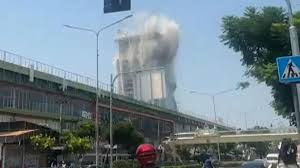On March 23, 2025, a tragic incident unfolded in the Saraya Gulabrai village of Ballia district, Uttar Pradesh, where a 20-year-old woman's body was discovered hanging from a tree under suspicious circumstances. The deceased had been alone at home for two days, as her parents were away for medical treatment at a hospital.
Upon receiving information about the incident, local police and senior officials promptly arrived at the scene to initiate an investigation. The formation of four dedicated teams underscores the gravity with which the authorities are approaching this case.
The deceased's grandmother provided a poignant account, stating that the victim's hands were tied behind her back and that the body was suspended from the tree, with her feet approximately six feet above the ground. She also mentioned that her granddaughter had been alone at home during this period. Notably, the victim's marriage had been scheduled for April 25, adding a layer of tragedy to the incident. The grandmother expressed concerns about potential enmity but also noted that she was not allowed a clear view of the body during the initial examination
Superintendent of Police Omveer Singh detailed the initial findings, highlighting that the victim's hands were indeed tied behind her back, and her feet were six feet above the ground. He noted that the victim's parents had been away for medical reasons, leaving her alone at home. The surrounding houses were situated approximately 40-50 meters away, and preliminary inquiries with villagers did not yield substantial information. The authorities have informed the victim's parents and are awaiting their return. Other family members, including a brother residing in Gujarat and a married sister in Assam, have also been notified. The body has been sent for post-mortem examination, with a request for videography to ensure transparency and accuracy in determining the cause of death. Four specialized teams, including local police and surveillance units, have been deployed to expedite the investigation.
In response to the incident, the victim's father filed a formal complaint, leading to the registration of a case against four individuals. The police have taken these suspects into custody for questioning to uncover potential leads and motives.
The incident has garnered attention from political figures as well. Samajwadi Party President Akhilesh Yadav expressed deep sorrow over the incident, describing it as a painful and tragic event. He criticized the state government's handling of law and order, suggesting that such incidents reflect a failure to protect citizens, particularly women. Yadav's remarks highlight concerns about the safety and security of women in the region.
Similarly, Mainpuri MP Dimple Yadav reacted to the incident, stating that the murder of a young woman in Ballia is extremely painful. She emphasized that the condition of women in Uttar Pradesh is unfortunate, with increasing crime rates leading to a decline in morale among women. She urged the government to take immediate action to ensure justice for the victim and her family.
This incident in Ballia is not isolated; similar cases have been reported in the region, raising concerns about women's safety. For instance, in March 2025, a 28-year-old woman was found hanging in her home under mysterious circumstances in Sahatwar, Ballia. The police initiated an investigation to determine whether it was a case of suicide or foul play.
The recurrence of such incidents underscores the urgent need for comprehensive measures to protect women and ensure their safety. It also highlights the importance of swift and transparent investigations to bring justice to the victims and their families.
As the investigation into the March 23 incident progresses, the authorities are expected to provide updates on their findings. The community and the victim's family await answers and justice for the young woman whose life was tragically cut short.

.jpg)
.jpg)

.jpg)
.jpg)
.jpg)

.jpg)
.jpg)


.jpg)
.jpg)

.jpg)


.jpg)


.jpg)
.jpg)

.jpg)


